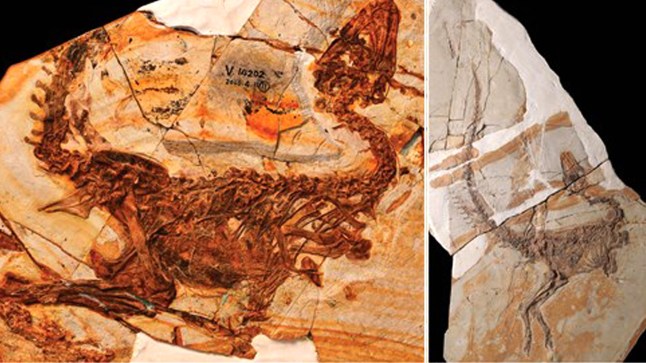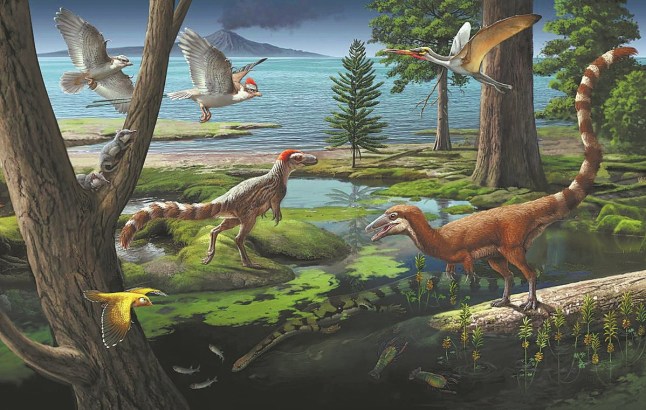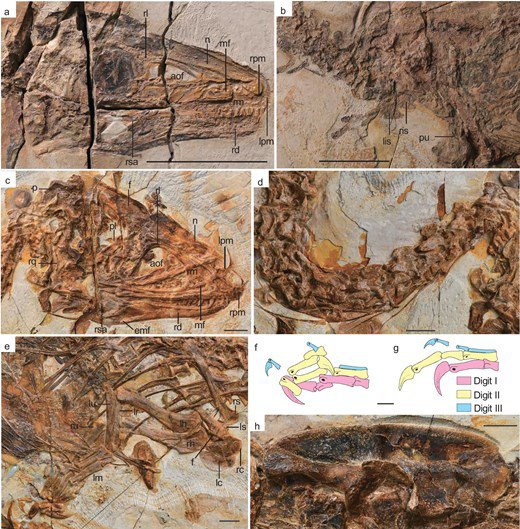
Dinosaur Top Trumps needs an update, as there are new contenders on the Early Cretaceous scene.
Researchers have discovered two new species in a 125-million-year-old fossil in China.
While they’d be wiped out by a T-Rex card, they’d still get a good killer rating if you were a rodent or small lizard.
The new dinos, similar to pint-sized predator Compsognathus, have been called Sinosauropteryx lingyuanensis and Huadanosaurus sinensis.
Professor Paul Barrett, a paleontologist with the UK’s Natural History Museum, told Metro: ‘They would have been quite small and speedy, with pointed heads lined with small, sharp teeth, a long graceful neck, two relatively long arms tipped with three-fingered hands for grasping prey, and a long, counter-balancing tail.
‘It’s likely both of them would have been covered with fuzz-like feathers.’

It’s not unusual to find a new species of dinosaur: he estimates about one a week is named around the world, both from new things being dug up, and old discoveries looked at with fresh eyes.
These fossilised remains, found in the Yixian rock formation, had actually been known about for around 20 years, but it is only now that analysis has revealed new secrets about the ancient lizards.
We can even see what one of them liked to eat for lunch, as the remains of two rodent-like mammals can be seen in its stomach.
Professor Barrett said: ‘We do get gut content in dinosaurs occasionally but it is quite rare, so this is a nice direct bit of evidence for what that animal had as its last meal.’
This is especially significant as it is the first fossil proof of dinosaurs preying on mammals in the Jehol Biota ecosystem in northeastern China, a region famed for its well-preserved dinosaur bones.

The names given to the dinosaurs reflect the location of their discovery. Breaking them down, sinosauropteryx lingyuanensis means ‘Chinese reptilian wing’ which was discovered near the city of Lingyuan.
Huadanosaurus, which is an entirely new classification, means somethng along the lines of ‘Great Anniversary Lizard’.
Writing in the National Science Review, researchers said the name ‘commemorates the 75th anniversary of the founding of the People’s Republic of China and the Chinese Academy of Sciences’.
Both the dinosaurs were small carnivores which would have eaten things like rodents, frogs, salamanders, and even baby dinosaurs.

Lead study author Qiu Rui told China Daily: ‘Huadanosaurus had robust jaws and powerful neck muscles, suggesting it could swiftly kill prey through its strong biting force, enabling it to hunt mammals efficiently.’
The dinosaurs are believed to have developed their different features due to tectonic plates shifting, creating isolated areas where dinosaurs evolved different features.
These two newcomers on the the dinosaur scene would have been roaming the world at around the same time as Iguanadon, Supersaurus, and Microraptor.
The region where they were found is where the first evidence of some dinosaurs having feathers was uncovered in 1995.
‘It’s one of the richest fossil deposits, in particular for these small, meat-eating dinosaurs,’ Professor Barrett said.
Get in touch with our news team by emailing us at webnews@metro.co.uk.
For more stories like this, check our news page.
MORE: Human teeth successfully grown in lab for first time
MORE: How to see the pink moon and blue giant star tonight
MORE: Seven good – and not-so-good – signs you may be a bit Neanderthal











